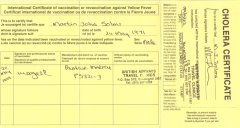|
The following vaccinations are required for an overland trip.
This list is not extensive and should only be used as a guideline. Consult
a travel clinic or your local GP prior to travelling.
 Yellow
Fever - This is a mosquito-borne viral disease. Illness ranges in
severity from a flu-like syndrome to severe Hepatitis and Hemorrhagic
(multiple systems are affected like vascular system) fever. Typically
found in sub-Saharan Africa and tropical South America. An international
Yellow Fever certificate is required. Yellow
Fever - This is a mosquito-borne viral disease. Illness ranges in
severity from a flu-like syndrome to severe Hepatitis and Hemorrhagic
(multiple systems are affected like vascular system) fever. Typically
found in sub-Saharan Africa and tropical South America. An international
Yellow Fever certificate is required.
Hepatitis A
- Usually transmitted via contaminated food and water. It attacks
the liver and my lead to jaundice and prolonged illness.
Hepatitis B
- This virus is transmitted sexually and by contaminated needles. The
vaccine is a three dose course over six months. Plan ahead so that you
don't run out of time to get immunised.
Typhoid
Fever - Typhoid Fever is more common in areas of the world where
hand washing is less frequent and water is likely to be contaminated with
sewage.
Tetanus
- This is a serious bacterial disease contracted following contamination
of deep puncture wounds. Typically if one is involved in a car accident.
The vaccine lasts for 10years.
 Cholera-
This virus is transmitted by contaminated food and water. The infection is
rare in travellers unless work is being done in refugee camps or
hospitals. Most countries only issue a Cholera certificate, however, there
is a new Cholera vaccination (oral type) which lasts for 2 years. Cholera-
This virus is transmitted by contaminated food and water. The infection is
rare in travellers unless work is being done in refugee camps or
hospitals. Most countries only issue a Cholera certificate, however, there
is a new Cholera vaccination (oral type) which lasts for 2 years.
Meningitis
- Typically only transmitted via infected persons. There are different
strains throughout Africa. There is a multi-strain vaccination available.
Malaria
- The most popular and dangerous disease that typically spreads by
mosquitoes that bite from dusk to dawn. Three types of drugs are
available: Doxycycline (1 tablet per day), Malarone (1 tablet per day) and
Mefloquine (Lariam - 1 tablet per week). All have different side effects
and total trip duration time lines.
Rabies -
Rabies is transferred from a bite of a rabied animal. The
infection affects the nervous system. Domestic animals only account
for 10% of the rabied population. Our worry is getting bitten by a
monkey or a dog.
Health
Links
|

